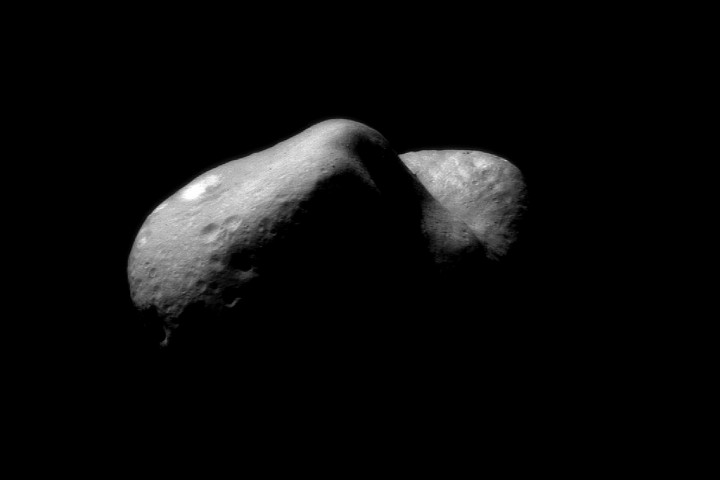Asteroid Mining
By David Ren 任大偉

Pursuing the science fiction ambition of space colonisation is becoming increasingly feasible with the advent of asteroid mining. A key limitation to the establishment of a space colony is the supply of resources. To procure the necessary building materials and energy sources, it would be impractical to rely on transportation from Earth. The prohibitively high cost of launching materials into space (as low as USD$2,500 per pound or USD$5,512 per kilogram [1] has led to innovative breakthroughs of in-situ resource consumption and management. For example, the European Space Agency (ESA) is investigating 3D-printing lunar habitats using the moon’s soil to avoid depending on logistics from Earth [2]. Underpinning efforts to colonise space is the provision of raw material from asteroids.
Asteroids are thought to be the leftover material from the formation of the solar system that Jupiter’s strong gravitational field prevented from accreting into a planet. They contain a variety of economically valuable minerals such as gold, platinum, and rhodium. The gravitational influence exerted on asteroids by surrounding planets frequently redirects their orbits. They become Near Earth Objects (NEOs) if they are within 45 million kilometres of Earth. NASA’s NEO Programme has detected over 13,000 asteroids between 1995 and 2005 (National Aeronautics and Space Administration, 2015). To illustrate the potential of these asteroids, the smallest known metallic Near Earth Asteroid (3554 Amun) contains a 1996 market value of USD$6 trillion in cobalt, USD$6 trillion in platinum-group metals, and USD$8 trillion in iron and nickel [3].
Water, the most important resource for survival, is most likely to be found within carbonaceous (C-type) asteroids, which also happens to be the most abundant type of asteroid in the solar system. The composition of the asteroid surface can be determined through spectroscopy. Sunlight incident upon the asteroid is partially absorbed by the surface compounds, which creates reflected light similar to that of an absorption spectrum. This can be detected with accuracy using telescopic spectrometers that can detect in X-ray, visible, and infrared. However, only approximately the top half of a millimetre of the asteroid can be analysed in this manner. As the internal composition is likely to vary, a probe is necessary to approach the target asteroid with analytical instruments. NASA’s OSIRIS-REx will investigate the asteroid Bennu in September 2016 with an instrument that injects nitrogen gas to force asteroid material into a collection tube, allowing 5 to 6 centimetres into the depths of an asteroid for analysis [4].
After identifying a suitable Near Earth Asteroid, the daunting task of extraction begins. Mining projects will most likely involve robots that cling to the asteroid’s surface to extricate the soil or regolith, to be subsequently transported to a processor. This processor would use solar energy to heat up the regolith to release water vapour. Fortunately, asteroids have low mass, hence weak gravitational fields. This makes cargo transportation relatively straightforward, especially since the water can be split into hydrogen and oxygen gas for rocket propellant.
Presently, there are no space colonies that could purchase these resources, and the technology that permits cost-effective space travel is currently unavailable. By using asteroids’ resources, the issue of terrestrial resource scarcity could potentially be alleviated [5].
References
[1] Chaikin, A. (2015, January). Is SpaceX Changing the Rocket Equation? Retrieved from Air & Space, Smithsonian: http://www.airspacemag.com/space/is-spacex-changing-the-rocket-equation-132285884/?no-ist
[2] European Space Agency. (2013, 01 31). Building a Lunar Base with 3D Printing. Retrieved from Space Engineering & Technology: http://www.esa.int/Our_Activities/Space_Engineering_Technology/Building_a_lunar_base_with_3D_printing
[3] Lewis, J. S. (1997). Mining the Sky: Untold Riches From The Asteroids, Comets, And Planets. Perseus Publishing.
[4] National Aeronautics and Space Administration. (2013, 08 03). New NASA Mission to Help Us Learn How to Mine Asteroids. Retrieved from NASA OSIRIS-REx: https://www.nasa.gov/content/goddard/new-nasa-mission-to-help-us-learn-how-to-mine-asteroids
[5] National Aeronautics and Space Administration. (2015, 12 20). NEO Discovery Statistics. Retrieved from Near Earth Orbit Program: http://neo.jpl.nasa.gov/stats/